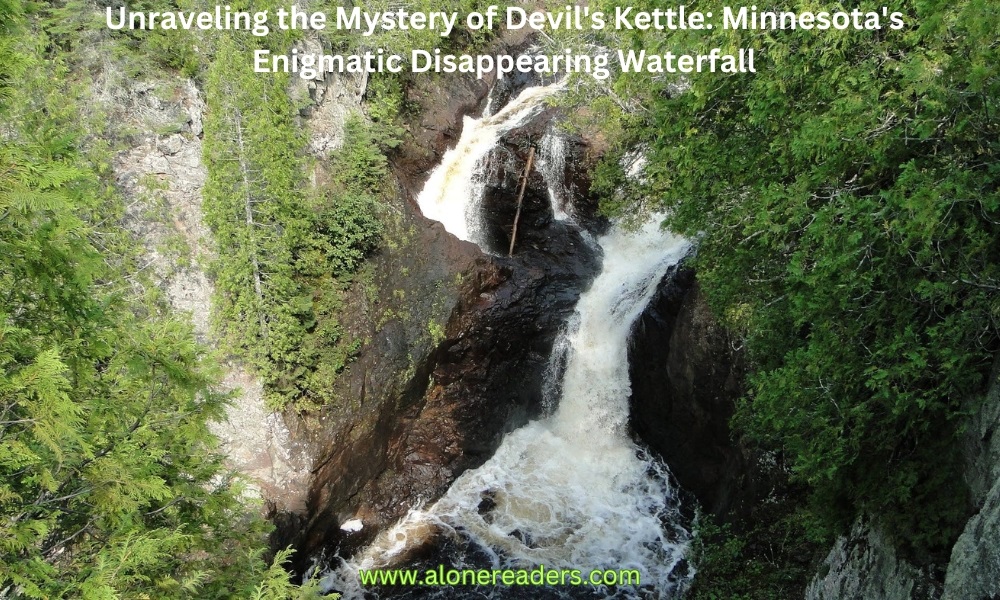
Nestled in the scenic landscape of Minnesota, the Devil's Kettle Waterfall presents one of nature's most baffling puzzles. Found along the North Shore of Lake Superior in Judge C.R. Magney State Park, this natural wonder has intrigued and mystified visitors and scientists alike for years. The waterfall is a part of the Brule River, which, as it approaches the lake, splits into two. One side continues its course, cascading into Lake Superior, while the other half plunges into a deep, seemingly bottomless pothole, disappearing without a trace. This phenomenon has earned the site its ominous name and a reputation as one of Minnesota's most enigmatic natural wonders.
The intrigue surrounding Devil's Kettle begins with the river's sudden and inexplicable loss. Theories have ranged from simple to the supernatural over the years. Some speculate that there must be an underground river or a hidden cave system that carries the water back to Lake Superior or to another water body. Others, influenced by the spot's mystique, suggest more otherworldly explanations.
The geology of the area provides some clues. The region is known for its volcanic rock and the rugged terrain shaped by glaciers. These factors contribute to the unique topographical features observed in Judge C.R. Magney State Park, where the Devil's Kettle is located. The pothole into which the river disappears is likely a result of the erosive power of water over thousands of years, a common process in the formation of waterfalls and rapids. However, the exact path the water takes after plunging into the kettle remains a mystery.
Several scientific expeditions have attempted to unravel this mystery. Researchers have dropped dye, ping pong balls, and other objects into the Devil's Kettle, hoping to spot them downstream or in Lake Superior, but to no avail. These experiments, rather than providing answers, have only deepened the mystery, as none of the objects were ever seen again.
The lack of visible outflow has also sparked curiosity. In most cases where water enters an underground system, there is usually a resurgence where the water reemerges, but no such resurgence has been found for the water entering Devil's Kettle. Hydrologists suggest that the water could be seeping out through the lake bed of Lake Superior, but the exact point of re-entry has eluded discovery.
Environmental and geological studies have attempted to measure the water volume entering and exiting the waterfall to determine if the amount of water reappearing in Lake Superior matches the volume lost in Devil's Kettle. These studies, while offering some insights, have yet to provide a definitive explanation. The challenge lies in accurately measuring the flow in such a dynamic and inaccessible environment.
The cultural and historical aspects of Devil's Kettle add another layer to its allure. Native American legends and local folklore are rich with references to the waterfall. To some, it is a sacred site, while others spin tales of monsters and spirits dwelling within the depths of the kettle. These stories, passed down through generations, contribute to the mystique and enduring fascination with this natural wonder.
The Devil's Kettle continues to be a popular destination for hikers, nature enthusiasts, and those drawn to its mystery. The hike to the waterfall is an adventure in itself, offering stunning views of the rugged Minnesota landscape and the powerful Brule River. The journey culminates at the waterfall, where visitors can witness the strange spectacle of half a river simply vanishing into the earth.
Despite the technological advancements and scientific knowledge available today, the Devil's Kettle remains an enigma. It stands as a testament to nature's capacity to awe and mystify, reminding us that there are still mysteries out there that elude explanation. As research continues and theories evolve, the fascination with Devil's Kettle is likely to grow, attracting more visitors and scientists alike, all drawn to the mystery of where half of the Brule River disappears.
In conclusion, the Devil's Kettle in Minnesota represents not just a geographical anomaly but also a symbol of the enduring allure of nature's mysteries. Its ability to captivate the imagination and challenge our understanding of the natural world makes it a unique and intriguing destination. Whether viewed through the lens of science, folklore, or sheer curiosity, the Devil's Kettle remains an enigmatic and mesmerizing feature of Minnesota's natural landscape, inviting exploration and wonder.